Doo Dah Parade 2009
"Slavery Is Not History...Yet!"
Some slaves were strategically planted along the route before the parade began. When our traffickers arrived, they involved the nearby spectators in bidding for the slaves. "The beard adds extra value!"
The crowd was very appreciative of the imaginative costumes of the slaves and traffickers and also receptive to our serious message. We handed out hundreds of bright pink information cards about human trafficking and our green UDHR bookmarks.
Stevi wrote,
"As we walked, many in the crowd applauded and shouted out respect for AI. As I gave a woman one of our bright pink info cards, she said, "I contribute to Amnesty." One of our best handouts, in my opinion, is a bookmark with the articles of the Declaration of Human Rights on it. My favorite targets for these were the kids. With even the little ones, I'd say, "I bet you have a book. You can put this bookmark in it." One guy who looked about 13 told me he doesn't read. I told him then for sure he should have a bookmark because he's just the kind of guy who needs to read. Most of the parents seemed pretty happy someone was pushing reading. I finished the parade empty handed: YAY!Congratulations to Marie-Helene and Robert W., the organizers of this successful event, and thanks to all 35 participants.Marie-Helene, Robert, Dan, Brooke, and their wonderful friends did another great job in planning, organizing and executing this event. I get a giant kick out of working with them. Their energy and creativity not only give me a charge, but they also, to use a recently overused but nonetheless true word, hope for the future of our country and our world. Thanx, kiddos.
I think it's okay for me to speak for everyone who participated: We had so much fun."
Here are a few of the many great photos available in Stevi's album (73), Paul's album (11), Karin's album (22), Limegreeney's album (108), and Marie-Helene's album (21). A huge thank-you to the photographers for sharing!

The Banners.

The Theme.
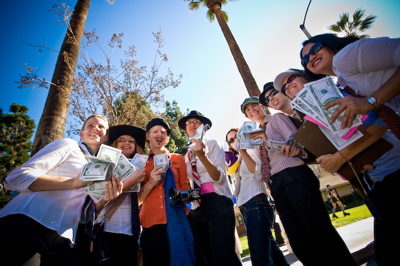
The Traffickers (with cash).

The Slaves.

The Organizer.
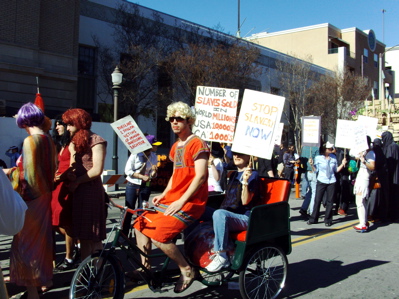
The Other Organizer and Protesters.
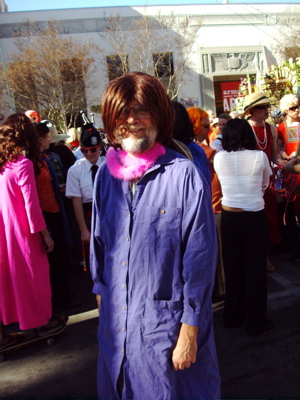
The Group 22 Co-Coordinator.

The Statistic.

The Mustaches.

Sign and cards and bookmarks.
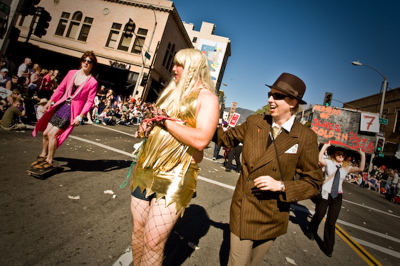
Slave and dealer.
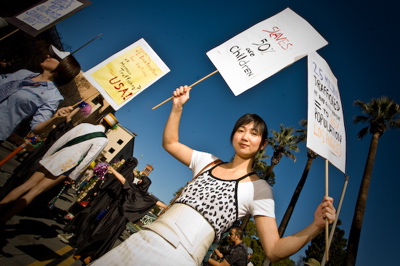
Protest signs held high.
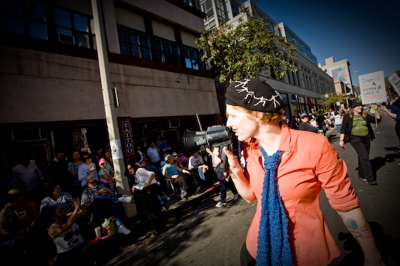
Bargaining for a slave with spectators.

Deal is made - money changes hands!

Group 22 celebrates another Doo Dah success.
Trafficking is modern day slave trading. It involves transporting people away from the communities they live in by the threat or use of violence, deception or coercion so they can be exploited as forced or enslaved workers. Trafficking is a fundamental abuse of human rights. Although in some cases, women and girls are abducted or coerced by traffickers, many start their journeys from their home countries voluntarily. They see ads offering attractive employment as nannies, waitresses, secretaries, models or dancers. All carry the promise of desperately needed money. For most of these women and girls, as soon as their journey begins, so does the systematic abuse of their rights, in a strategy that reduces them to dependency on their trafficker, and later their "owner". Their documents are taken away from them; they may be beaten; they will - almost certainly if they start to protest - be raped.
Escape is almost impossible. Trafficked women are usually trapped by threats, coercion, or literally being locked inside. Many trafficked girls and women report being told that their families and their children would be harmed or murdered if they tried to escape or tell anyone.
(excerpts from AI fact sheet on Human Trafficking)
Trafficking is a crime under international law under the
UN Protocol to Prevent, Suppress, and Punish Trafficking in Persons.
For more information on trafficking or women's human rights,
visit AIUSA's Stop Violence Against Women website.
UN Protocol to Prevent, Suppress, and Punish Trafficking in Persons.
For more information on trafficking or women's human rights,
visit AIUSA's Stop Violence Against Women website.